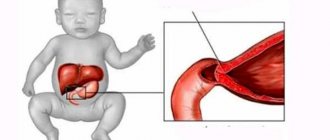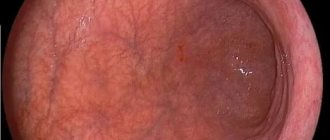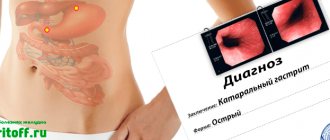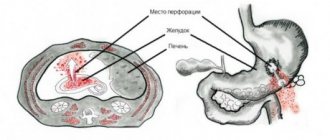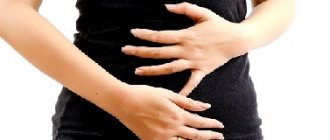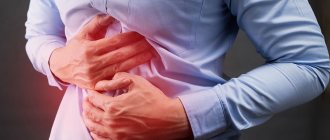Gastric peristalsis is an important function in the digestive system of the body, which processes and evacuates the bolus of food from the organ to the small and large intestines. Its muscle fibers, which have a circular and longitudinal structure, contract in a certain mode, creating a wave that moves the food bolus.
These movements occur reflexively, therefore a person cannot influence this process with consciousness, since the autonomic nervous system “controls” the motor function of the digestive organ. Depending on the state of the stomach, when there is food in it or not, the rate of contraction of muscle fibers will be different.
Gastric motility
As soon as the food bolus enters the junction of the esophagus and the stomach, muscle contraction of the organ begins. There are three types of motor skills:
- rhythmic contraction of muscle fibers - begins gradually in the upper part of the organ, with intensification in the lower part;
- systolic muscle movements - at the same time there is an increase in muscle contractions in the upper part of the stomach;
- general movements - contraction of all muscle layers of the stomach leads to a reduction in the food bolus by grinding it with the help of gastric secretions. Depending on the type of food, part of it, after processing in the stomach, is evacuated into the duodenum, and part of the food bolus remains in the stomach for further grinding and digestion by gastric enzymes.
Depending on how the peristalsis of the stomach works, the health of the entire digestive system of the body depends.
What is delayed gastric emptying?
Delayed gastric emptying is a situation in which food remains in the stomach for an abnormally long period of time. Delayed bowel movements are usually caused by a disorder (such as diabetes, a connective tissue disorder, or a neurological disorder) that affects the nerves leading to the digestive tract.
Too much food in the stomach leads to excessive stretching of its walls, which disrupts the digestion of food. As a result, there is a slow movement of food through the gastrointestinal tract, which causes a feeling of heaviness in the upper abdomen, difficulties with bowel movements and other digestive problems.
Delayed emptying in the stomach and abdomen is often caused by too long periods of time between meals, as well as by improper diet. One of the common causes of digestive disorders is the habit of having a heavy dinner before bed: the stomach, not having the opportunity to rest at night, may show its “dissatisfaction” with a feeling of heaviness after eating.
An unusually large meal overloads the digestive organs, which are unable to process the contents of the stomach with acids and enzymes.
Delayed gastric emptying is a situation in which food remains in the stomach for an abnormally long period of time.
As a result, a feeling of heaviness and fullness develops in the upper abdomen and food is retained in the stomach. In some cases, indigestion may occur after eating whole milk and dishes in which it was used. This may indicate an individual intolerance to the components of milk; when it is excluded from the diet, digestion, as a rule, normalizes.
If there is a delay in gastric emptying after eating, it is necessary to perform certain actions that will restore the functioning of the gastrointestinal tract. Try to abstain from food for several hours, replacing it with drinking still water.
It will also be useful to lie down for a few minutes, stretch out your whole body and breathe deeply, and then take a leisurely walk - no matter on the street or around the room. Despite the feeling of discomfort in your stomach that you experience, try not to go to bed, on the contrary: you should maintain an upright position for 1–3 hours.
Pathological changes in gastric motility
A disorder of the contractile ability of the stomach can be primary, that is, congenital or acquired, and secondary, which occurs as a consequence of other diseases of the body. Impaired gastric motility leads to the following pathological conditions in the functioning of the digestive organ:
- violation of the muscle tone of the stomach - the contractility of the muscular frame of the organ can be increased, decreased or completely absent, that is, be in hypertonicity, hypotonicity or atony. This pathology affects the digestion function of the food bolus. The stomach muscles cannot fully absorb a portion of food for digestion, followed by its evacuation into the duodenum;
- weakening of the sphincter - a condition develops when a bolus of food, not treated with gastric secretions, falls into the intestines. With increased muscle tone, stagnation of gastric contents occurs, as a result of which pathological processes in the stomach begin to develop;
- slowing or accelerating peristalsis of the digestive organ - this pathology provokes an imbalance in the intestines, which leads to uneven absorption of food in the intestines. The liquid component of the gastric contents can be evacuated into the intestines much earlier, and the solid elements remaining in the stomach will be much more difficult to digest;
- gastric evacuation disorder - a violation of the tone and muscle contractions of the digestive organ, leading to an accelerated or delayed process of evacuation of food from the gastric organ to the intestines.
Impaired motility is the result of various diseases of the stomach and intestines, such as gastritis, peptic ulcers, erosions, benign and malignant tumors, which affect the quantitative production of enzymes or hydrochloric acid in gastric juice. Peristaltic disorders can also occur during surgery on an organ or due to blunt trauma to the abdomen.
Deterioration of the motor function of the gastric organ is possible as a complication of diseases of other body systems, such as the endocrine system, when diabetes mellitus indirectly affects gastric motility. With hypoglycemia, the amount of glucose in the blood decreases, which begins to affect the enzymatic composition of gastric juice, as a result of which the function of muscle contraction of the digestive organ suffers.
Important! Problems that appear in the digestive system, in the form of disturbances in gastric motility, accompanied by clinical manifestations, require mandatory examination and treatment by a gastroenterologist, and, first of all, the underlying disease.
Disorders of motor function of the stomach
Disorders of gastric motility may manifest as changes in muscle tone or changes in peristalsis
.
The phenomena of decreased or increased muscle tone of the stomach are usually expressed in weakening or strengthening of the peristole
. Peristole refers to the ability of the stomach to absorb food mass. The peristole depends on the tone and elasticity of the muscle wall, mainly its fundal part (Fig. 120).
Rice. 120. Different shapes of the stomach. 1 - hypertensive; 2 - normotonic; 3 - hypotonic; 4 - atonic
Impulses that increase the tone of the stomach usually come through the vagus, and those that decrease the tone - through the sympathicus. Excitation of the splanchnic nerves entails an increase in the tone of the cardia and pyloric sphincter.
Increased stomach tone
sometimes observed in physically developed men in the form of a shortened stomach with an increased diameter of the upper part and the deepest location of the pylorus.
Atony, or relaxation, of the stomach, a decrease in its tone can occur as a result of paresis of the muscle layer and reflexively when obstacles arise locally in the movement of food masses to the outlet of the stomach (neoplasms, scars). A decrease in gastric tone can be caused by mental factors (anxiety, depression) that influence through the diencephalon.
Atony may lead to dilatation of the stomach. Acute dilatation of the stomach develops from paralysis of the neuromuscular apparatus of the stomach as a result of damage to the splanchnic nerves, surgical trauma or infection. In this case, the evacuation of stomach contents stops. The food masses accumulated in it are subject to fermentative and putrefactive decay.
Weakening of gastric peristalsis
most often occurs with an atonic stomach, inhibition of the function of the parasympathetic nervous system, as well as with severe inflammatory processes (gastritis and perigastritis), when the distensibility of the stomach wall decreases, with cachexia and severe (callous) ulcers.
In a dog, after resection of the pyloric part or anastomosis between the stomach and a loop of small intestines (an operation of gastroentero-anastomosis, now rarely performed in humans in connection with an ulcer or stomach cancer), a sharp weakening of the motor ability of the stomach occurs. At the same time, it makes it easier to throw duodenal juice into the stomach. The time required for the movement of food masses into the duodenum increases by 2 - 3 times (E. S. London).
Increased gastric peristalsis
(hyperkinesis) or so-called peristaltic restlessness, depends mainly on nerve impulses, in particular those coming from the brain and spinal cord. Increased peristole and peristaltic movements are associated with increased irritability of the vagus nerve. Tabular crises (with tabes dorsalis) are accompanied by increased peristalsis, apparently due to irritation of the autonomic centers of the spinal cord.
A special case of hyperkinesis - spastic contraction of the stomach - may depend on the general condition of the nervous system, as well as on inflammatory irritations. With organic or functional narrowing of the pyloric opening, increased peristalsis of the stomach is observed, followed by hypertrophy of its muscles. Rough food, alcohol, lactic acid, histamine, choline substances, insulin increase gastric motility. This ensures the timely transfer of stomach contents to the duodenum.
The movement of food towards the duodenum depends mainly on the motor activity of the pylorus
.
Depending on the motor activity of the pylorus, gastric emptying either slows down or accelerates, which causes disruption of gastric digestion.
Expedited evacuation
gastric contents occurs in most cases due to
a decrease in the acidity of gastric juice
and is especially pronounced with achlorhydria or achylia.
This is explained by the fact that contractions of the pylorus are functionally related to the rate of neutralization of portions of gastric juice in the initial part of the duodenum
. If the acidity is reduced, then the neutralization of food gruel by the contents of the duodenum occurs quickly and conditions are created in which contractions of the pyloric part are reflexively inhibited; the pylorus opens and food mass easily passes into the duodenum. Motor insufficiency of the pylorus itself can lead to acceleration of evacuation, for example, during inflammatory processes, sometimes due to a cancerous tumor in it. In addition, an excessively full duodenum causes prolonged closure of the pylorus, while an empty one causes it to open.
Slowing down the evacuation of stomach contents
observed more often.
Here, what is primarily important are mechanical obstacles
to the movement of food, which can occur due to dysfunction of the pylorus or organic changes in it (narrowing of its lumen from scars, tumors, compression).
A significant role is played by the increased acidity of gastric juice
and the delayed neutralization of portions of food entering the duodenum, which reflexively causes a delayed opening of the pylorus.
It is impossible to deny the possibility of slow movement of food in the stomach due to its general spastic state or pyloric spasm
, which may occur due to a violation of autonomic nervous regulation. Often the spasm depends on the presence of an ulcer in the pyloric part, as well as on reflex irritations coming from other organs.
As a result of disorders of the motor activity of the stomach, especially its pyloric part, food stagnates in it.
The consequences of indigestion vary
. Gastric digestion disorders lead to weakened digestion in the intestines.
When food is retained in the stomach and its evacuation into the intestines is delayed, abnormal processes of gastric digestion develop. Due to the stagnation of food masses, processes of bacterial decomposition occur, accumulation of decay products and gases irritate the gastric mucosa and cause heartburn, pain, nausea, and vomiting.
Secretory and motor disorders in gastric digestion affect other properties of gastric juice. In particular, one should keep in mind its antiseptic effect
.
It is known that normal gastric juice has a bactericidal effect, for example, against pathogenic microbes (cholera, typhoid fever). It prevents the development of rotting and fermentation processes. These properties of gastric juice may be impaired due to changes in secretion and rate of gastric emptying. The mucus content in the stomach
also changes : it is reduced in the case of high acidity and increased in the case of low acidity.
Disorders of the secretory activity of the stomach affect the condition of the whole organism
. An increase in the secretion of gastric juice leads to a depletion of the body in chlorine and acid radicals. As a result, a shift in the acid-base balance to the alkaline side is detected. Shifts in acid-base balance are leveled out due to the reabsorption of gastric juice into the intestine. But in the presence of pyloric stenosis, the flow of gastric juice into the intestine and its absorption there is insufficient or noticeably delayed.
Motor disorders include belching, heartburn and vomiting
, which often accompany digestive disorders.
Belching
causes the release of air from the stomach that has entered there as a result of swallowing (especially when the larynx is closed), as well as gases (hydrogen sulfide, carbon dioxide, methane), if they have formed in it as a result of impaired digestion. The mechanism of belching is that in conditions of an open cardial part of the stomach and spasm of the pylorus, the diaphragm, which descends during inhalation, and the tense abdominal press press on the stomach. In this case, contraction of the gastric walls is also important. These phenomena are most likely caused by reflexes from the stomach or peritoneum itself.
Heartburn
, a burning sensation, occurs when the contents of the stomach are thrown into the esophagus due to gastric antiperistalsis.
Vomit
is a complex act of disruption of the motor activity of the stomach and breathing, accompanied by the involuntary ejection of food from the stomach to the outside (Fig. 121).
It can occur due to pyloric stenosis and irritation of the mucous membrane. First comes a feeling of weakness, dizziness, paleness of the face, nausea, and then the actual act of vomiting: a deep breath, strong contraction of the abdominal muscles, contraction and sharp lowering of the diaphragm, and when the pylorus closes, contractions of the stomach itself and opening of the cardia
the ejection of food from the stomach through the esophagus into the cavity mouth and out. In this case, lowering the epiglottis, raising the larynx and closing the glottis prevents vomit from entering the respiratory tract. The contraction of the muscles that lift the soft palate prevents the penetration of these masses into the nasal cavity. In addition, severe vomiting is accompanied by increased antiperistalsis of the duodenum and jejunum. In this case, bile from the duodenum may be mixed with the food masses, where it is intensively supplied due to compression of the gallbladder and bile ducts.
Rice. 121. Curve of vomiting movements of the stomach (upper curve), duodenum (middle curve) and small intestine (lower curve) (according to E. B. Babsky)
The act of vomiting occurs due to irritation of the vomiting center in the medulla oblongata. The vomiting center is associated with the function of those devices that take part in vomiting. Some poisons (apomorphine), intoxication (for example, with infections, uremia), as well as pathological phenomena in the medulla oblongata (for example, with meningitis, compression of the brain by tumors or concussion) can cause vomiting. But more often it has a reflex origin - irritation from the branches of the vagus nerve of the cardiac part of the stomach, glossopharyngeal nerve, intestinal mucosa, peritoneum, liver, uterus and other organs. Simultaneously with the act of vomiting, an increase in salivation and sweating can be observed, which indicates a general excitation of the central nervous system that accompanies the act of vomiting. When vomiting occurs, the heartbeat quickens and blood pressure drops with sharp fluctuations.
Vomiting is usually preceded by a feeling of nausea
, which is characterized by unpleasant sensations in the throat and stomach and is accompanied by paleness, sweating, accelerated heart activity, slowed respiratory movements, and salivation. At the same time, contractions of the esophagus and stomach stop, the pylorus is closed. This phenomenon probably occurs due to irritation of the thalamic region by afferent impulses emanating from various parts of the gastrointestinal tract.
Symptoms of motor dysfunction
Pathological changes in gastric motility in the form of delayed evacuation of the food bolus provoke the appearance of symptoms such as:
- syndrome of rapid food saturation - with low tone of the gastric organ, due to the slow evacuation of stomach contents, eating a small portion of food causes heaviness and a feeling of fullness in the stomach;
- heartburn and pain in the epigastric region - reflux of gastric contents into the esophagus occurs due to weakness of the sphincter of the cardiac part of the gastric organ;
- nausea, vomiting;
- belching with sour air;
- drowsiness after eating;
- weight loss;
- bad breath due to gastric atony.
Signs of accelerated evacuation of a food bolus from an organ are characterized by the following symptoms:
- pain in the epigastric region;
- nausea;
- abdominal pain of a cramping nature;
- periodic stool disorders in the form of diarrhea.
The presence of such pathological manifestations of the digestive system requires examination for diseases of the digestive organs, which were the cause of impaired motility of the digestive organ.
About spasms of the gastrointestinal tract
Pylorospasm is a disturbance in the functioning of the gastrointestinal tract, characteristic of infancy. In this case, it is implied that the baby has spasms in the stomach and duodenum. It is in this place that the pylorus of the stomach is located. In a child, the sphincter may contract convulsively, which becomes an obstacle to the normal flow of food from the stomach into the duodenum. Pylorospasm is characterized by fountain-like vomiting; blood clots may appear in the vomit.
The abdomen usually moves spasmodically, the baby is exhausted, and in some cases there are even growth problems. Vomit may resemble milky liquid or curd mass. Pylorospasm is usually not characterized by persistent symptoms. In addition, children with this disease may have a tendency to have problems with bowel movements.
In addition to problems with the pylorus of the stomach, pylorospasm can occur due to insufficient secretion of hormones produced by the stomach. Pylorospasm is also typical for children who have disturbances in the functioning of the central nervous system.
As a rule, by the 3rd month of a child’s life, pylorospasm disappears if parents often hold the child in an upright position. If pyloric spasm continues to bother you in the next months of life, then medical intervention will be required.
Source of the article: https://grudnichky.ru/zdorove/pishhevarenie-grudnichkov.html
Diagnostics
Diagnosis is carried out on the basis of a study of the patient’s objective data, laboratory tests, and instrumental examination methods:
- X-ray of the stomach with barium is a method that allows you to track the motor and evacuation functions of the organ;
- Ultrasound – abnormalities in the muscle layer of the stomach are monitored;
- electrogastrography – examines the motility of the gastric organ;
- endoscopy - the sensitivity threshold of the stomach wall is determined.
After examination and clarification of the cause of the malfunction in the motor function of the body’s digestive system, treatment is prescribed.
Treatment of peristalsis disorders
Treatment of gastric motility must necessarily be comprehensive, which, in addition to medications that improve peristalsis, is carried out with mandatory adherence to a diet in the diet.
Diet
For successful treatment, a necessary condition is adherence to the daily regimen:
- eating 5-6 times a day with short intervals between them;
- small portions, one-time consumption of food products in a volume of no more than 200 grams;
- stop eating three hours before bedtime;
- steaming or stewing food;
- dishes in the diet are presented in the form of pureed soups, slimy porridges, chopped dietary meat of chicken, turkey, rabbit;
- exclude the consumption of certain foods, such as peas, beans, lentils, cabbage, grapes, raisins, which contribute to increased gas formation in the stomach;
- daily consumption of fermented milk products;
- water ration consumption is about 1.5-2 liters of liquid.
After clarifying the diagnosis and establishing the cause of disturbances in the motor function of the stomach, medications are prescribed to improve the motility of the digestive organ.

